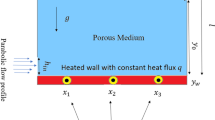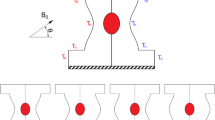Abstract
This work contains computational simulation of natural convection through U-shaped cavity saturated with water-based ferroparticles under the impact of magneto-hydrodynamic (MHD). Uniform and linear heat has been provided to an enclosure through the bottom and side walls, respectively, whereas the remaining walls are kept adiabatic. Physical problem has been expressed mathematically with the help of Navier–Stokes equations coupled with energy equation. Galerkin’s weighted residual technique of finite element simulation is adopted to convert the system of nonlinear partial differential equations (PDEs) into a nonlinear algebraic system and has been further solved using the Newton–Raphson method. Obtained numerical results have shown through graphs of streamlines, heatlines, isotherms, local and average Nusselt numbers against the wide ranges of parameters such as concentration of ferroparticles (φ = 0.0–0.06), Rayleigh (Ra = 104–107) and Hartmann number (Ha = 0–100) with Prandtl (Pr = 6.83). Results display that the influence of ferroparticles \((\phi )\) in the base fluid (water) increased the intensity bowls of streamlines and heat transfer rate within the enclosure. Furthermore, the reversed behavior has noticed for the case of increasing Hartmann number. The outcomes of the current work can be useful in optimizing designs and obtaining geometric parameters for effective energy transport in heat exchangers, solar collectors, nuclear magnetic resonance imaging, chemical reactors and dye removal from textile wastewater through advanced oxidation processes.









Similar content being viewed by others
Data Availability Statement
This manuscript has associated data in a data repository. [Authors’ comment: All data generated or analyzed during this study are included in this published article.]
References
S. Ostrach, Natural convection in enclosures. J. Heat Transf. 110, 1175–1190 (1988). https://doi.org/10.1115/1.3250619.
T. Fusegi, J.M. Hyun, K. Kuwahara, B. Farouk, A numerical study of three dimensional natural convection in a differentially heated cubical enclosure. J. Heat Mass Transf. 34, 1543–1557 (1991). https://doi.org/10.1016/0017-9310(91)90295-p
M. Hajmohammadi, M. Rahmani, A. Campo, O. Joneydi Shariatzadeh, Optimal design of unequal heat flux elements for optimized heat transfer inside a rectangular duct. Energy 68, 609–616 (2014). https://doi.org/10.1016/j.energy.2014.02.011.
N. Yucel, H. Turkoglu, Natural convection in rectangular enclosures with partial heating and cooling. Heat Mass Transf. 29, 471–477 (1994). https://doi.org/10.1007/bf01539499.
B. Kanimozhi, M. Muthtamilselvan, Q.M. Al-Mdallal, B. Abdalla, Combined Marangoni and Buoyancy convection in a porous annular cavity filled with Ag–MgO/water hybrid nanofluid. Curr. Nanosci. 19(1), 4–14 (2023). https://doi.org/10.2174/1573413717666210921153441.
B. Kanimozhi, M. Muthtamilselvan, Q.M. Al-Mdallal, B. Abdalla, Coupled buoyancy and Marangoni convection in a hybrid nanofluid-filled cylindrical porous annulus with a circular thin baffle. Eur. Phys. J. Spec. Top. 231(13–14), 2645–2660 (2022). https://doi.org/10.1140/epjs/s11734-022-00594-7.
A.A. Bozhko, G. Putin, T. Tynjala, P. Sarkomaa, Experimental and numerical investigation of wave ferrofluid convection. J. Magn. Magn. Mater. 316, 433–435 (2007). https://doi.org/10.1016/j.jmmm.2007.03.105.
T.C. Jue, Analysis of combined thermal and magnetic convection ferrofluid flow in a cavity. Int. Commun. Heat Mass Transf. 33, 846–852 (2006). https://doi.org/10.1016/j.icheatmasstransfer.2006.02.001.
P. Bissell, P. Bates, R. Chantrell, K. Raj, J. Wyman, Cavity magnetic field measurements in ferrofluids. J. Magn. Magn. Mater. 39, 27–29 (1983). https://doi.org/10.1016/0304-8853(83)90390-6.
M. Pirmohammadi, M. Ghassemi, Effect of magnetic field on convection heat transfer inside a tilted square enclosure. Int. Commun. Heat Mass Transf. 36, 776–780 (2009). https://doi.org/10.1016/j.icheatmasstransfer.2009.03.023.
B. Iftikhar, M.A. Siddiqui, T. Javed, Natural convection and thermal radiation analysis inside the square cavity filled with non-Newtonian fluid via heatlines and entropy generation. Phys. Scr. 97(2), 025202 (2022). https://doi.org/10.1088/1402-4896/ac48a8.
C. Sivaraj, M.A. Sheremet, MHD natural convection and entropy generation of ferrofluids in a cavity with a non-uniformly heated horizontal plate. Int. J. Mech. Sci 149, 326–337 (2018). https://doi.org/10.1016/j.ijmecsci.2018.10.017.
S.U. Choi, J.A. Eastman, Enhancing thermal conductivity of fluids with nanoparticles, Argonne National Lab. (ANL), Argonne, IL (United States). (No. ANL/MSD/CP-84938; CONF-951135–29 (1995)
L. Godson, B. Raja, D.M. Lal, S.E.A. Wongwises, Enhancement of heat transfer using nanofluids—an overview. Renew. Sustain. Energy Rev. 14, 629–641 (2010). https://doi.org/10.1016/j.rser.2009.10.004.
R. Saidur, K.Y. Leong, H.A. Mohammed, A review on applications and challenges of nanofluids. Renew. Sustain. Energy Rev. 15, 1646–1668 (2011). https://doi.org/10.1016/j.rser.2010.11.035.
P. Sivashanmugam, Application of nanofluids in heat transfer. An overview of heat transfer phenomena, 16 (2012), pp. 411–440. https://doi.org/10.5772/52496.
A. Akbarzadeh, M. Samiei, S. Davaran, Magnetic nanoparticles: preparation, physical properties, and applications in biomedicine. Nanoscale Res. Lett. 7, 1–13 (2012). https://doi.org/10.1186/1556-276x-7-144.
S. Singamaneni, V.N. Bliznyuk, C. Binek, E.Y. Tsymbal, Magnetic nanoparticles: recent advances in synthesis, self-assembly and applications. J. Mater. Chem. 21, 16819–16845 (2011). https://doi.org/10.1039/c1jm11845e.
S.K. Brar, M. Verma, R.D. Tyagi, R.Y. Surampalli, Engineered nanoparticles in wastewater and wastewater sludge—evidence and impacts. Waste Manag. 30, 504–520 (2010). https://doi.org/10.1016/j.wasman.2009.10.012.
J.L. Neuringer, R.E. Rosensweig, Ferrohydrodynamics. Phys. Fluids 7, 1927–1937 (1964). https://doi.org/10.1063/1.1711103.
R.E. Rosensweig, Magnetic fluids. Annu. Rev. Fluid Mech. 19, 437–461 (1987). https://doi.org/10.1146/annurev.fl.19.010187.002253.
S. Mojumder, S. Saha, S. Saha, M.A.H. Mamun, Effect of magnetic field on natural convection in a C-shaped cavity filled with ferrofluid. Procedia Eng. 105, 96–104 (2015). https://doi.org/10.1016/j.proeng.2015.05.012.
T. Javed, M.A. Siddiqui, Effect of MHD on heat transfer through ferrofluid inside a square cavity containing obstacle/heat source. Int. J. Therm. Sci. 125, 419–427 (2018). https://doi.org/10.1016/j.ijthermalsci.2017.12.009.
K.M. Rabbi, S. Saha, S. Mojumder, M.M. Rahman, R. Saidur, T.A. Ibrahim, Numerical investigation of pure mixed convection in a ferrofluid-filled lid-driven cavity for different heater configurations. Alex. Eng. J. 55, 127–139 (2016). https://doi.org/10.1016/j.aej.2015.12.021.
F. Selimefendigil, H.F. Öztop, Forced convection of ferrofluids in a vented cavity with a rotating cylinder. Int. J. Therm. Sci. 86, 258–275 (2014). https://doi.org/10.1016/j.ijthermalsci.2014.07.007.
R. Moradi, A. Mahyari, M.B. Gerdroodbary, A. Abdollahi, Y. Amini, Shape effect of cavity flameholder on mixing zone of hydrogen jet at supersonic flow. Int. J. Hydrog. Energy 43, 16364–16372 (2018). https://doi.org/10.1016/j.ijhydene.2018.06.166.
C. Ozalp, A.H.M.E.T. Pinarbasi, B. Sahin, Experimental measurement of flow past cavities of different shapes. Exp. Therm. Fluid Sci. 34, 505–515 (2010). https://doi.org/10.1016/j.expthermflusci.2009.11.003.
M.A.Y. Bakier, Flow in open C-shaped cavities: how far does the change in boundaries affect nanofluid. Int. J. Eng. Sci. Technol. 17, 116–130 (2014). https://doi.org/10.1016/j.jestch.2014.04.007.
T. Basak, S. Roy, Role of ‘Bejan’s heatlines’ in heat flow visualization and optimal thermal mixing for differentially heated square enclosures. Int. J. Heat Mass Transf. 51, 3486–3503 (2008). https://doi.org/10.1016/j.ijheatmasstransfer.2007.10.033.
V.V. Syzrantsev, K.V. Zobov, A.P. Zavjalov, S.P. Bardakhanov, The associated layer and viscosity of nanoliquids. Dokl. Phys. 60, 46–48 (2015). https://doi.org/10.1134/s1028335815010103.
S. Mukherjee, P.C. Mishra, P. Chaudhuri, Stability of heat transfer nanofluids—a review. ChemBioEng Rev. 5, 312–333 (2018). https://doi.org/10.1002/cben.201800008.
W. Yu, S.U.S. Choi, The role of interfacial layers in the enhanced thermal conductivity of nanofluids: a renovated Maxwell model. J. Nanoparticle Res. 5, 167–171 (2003). https://doi.org/10.1023/a:1024438603801.
H.C. Birkman, The viscosity of concentrated suspensions and solution. J. Chem. Phys. 20, 571 (1952). https://doi.org/10.1063/1.1700493.
J.C. Maxwell-Garnett, Colours in metal glasses and in metallic films. Phil. Trans. R. Soc. Lond. A 203, 385–420 (1904). https://doi.org/10.1098/rsta.1904.0024.
J.N. Reddy, Introduction to the Finite Element Method (McGraw-Hill, 2019). https://doi.org/10.1093/acprof:oso/9780198525295.003.0002.
V.A.F. Costa, Unification of the streamline, heatline and massline methods for the visualization of two-dimensional transport phenomena. Int. J. Heat Mass Transf. 42, 27–33 (1999). https://doi.org/10.1016/s0017-9310(98)00138-0.
Author information
Authors and Affiliations
Corresponding author
Rights and permissions
Springer Nature or its licensor (e.g. a society or other partner) holds exclusive rights to this article under a publishing agreement with the author(s) or other rightsholder(s); author self-archiving of the accepted manuscript version of this article is solely governed by the terms of such publishing agreement and applicable law.
About this article
Cite this article
Iftikhar, B., Siddiqui, M.A. & Javed, T. Computational analysis of heat transfer via heatlines for MHD natural convection ferrofluid flow inside the U-shaped cavity. Eur. Phys. J. Plus 138, 164 (2023). https://doi.org/10.1140/epjp/s13360-023-03769-w
Received:
Accepted:
Published:
DOI: https://doi.org/10.1140/epjp/s13360-023-03769-w




